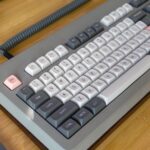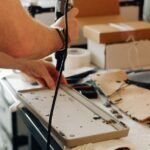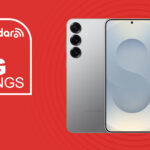Why you can trust TechRadar
We spend hours testing every product or service we review, so you can be sure you’re buying the best. Find out more about how we test.
Philips Barista Brew: two-minute review
The Philips Barista Brew is an espresso machine that can either hand-hold you through brewing espresso by automating part of the process, or leave you to do everything manually once you’ve built up your confidence. It’s a nice idea that should help smooth out the typical learning curve.
The machine heats quickly, and has a useful pressure gauge on the front that lets you see whether you’ve achieved the optimal pressure while pulling a shot of espresso. The controls are simple to understand and use, and although the Barista Brew takes longer to master than some other machines I’ve tested recently (such as the De’Longhi La Specialista Touch), once accustomed to its idiosyncrasies, you’ll be able to create consistently good coffee with minimal fuss (and only a scattering of grounds on your kitchen worktop).
For me, the Philips Barista Brew had two main drawbacks: the automatic dosing and the tamper. Both issues are solvable, though; but they do mean that this is a good coffee machine rather than a great one.
On its default settings, the Barista Brew ground far too much coffee for a double shot of espresso, and I needed to reduce the grind time by half to get an appropriate dose. Changing settings isn’t too difficult using the instruction booklet, but I can’t help but feel that the presets should be better configured, since making big changes to the standard settings may be outside the comfort zone of people new to coffee-making.
My other issue was the tamper, which is spring-loaded and limits the amount of pressure you can put on the coffee puck. Despite the coffee being finely ground, my shots often poured too fast, and the pressure gauge on the front of the machine showed that it was failing to reach the optimal nine bars.
I found a few solutions. Grinding the coffee more coarsely means it takes up more space (imagine the difference between a bucket full of sand and one full of rocks), with it usually resulting in a faster pour because water will find its way through the grounds more quickly. But here, if you dial the grinder just right, you may be able to tamp hard enough to cancel out that effect.
Another option is to simply grind more coffee, so there’s more for the tamp to compress; but this feels like a waste of beans. As with any espresso machine, add too much to your basket and it will make contact with the brew head when you insert the handle, which will stop the water passing through properly.
Finally, you can stick with your preferred grind size and dose, and use a simple third-party tamper to compress the puck rather than Philips’ spring-loaded unit. While this one feels nice in the hand, I can’t help but feel it’s over-engineered.
Nevertheless, it’s important to bear in mind the price of the Barista Brew when you’re comparing it to others in the same category. Although I found the De’Longhi La Specialista Touch easier to master, the Barista Brew is much cheaper at its currently reduced price when you buy direct from Philips. If you don’t get along with the “calibrated” tamper, you can buy a good-quality unit separately and still pay a lot less.
It’ isn’t perfect, but the Philips Barista Brew is very good for the price, and is definitely one to consider if you’re looking for a compact, all-in-one espresso machine that won’t break the bank.
Philips Barista Brew: price and availability
- List price $649.99 / £580.99 (about AU$1,000)
- For sale in US and Europe
- Dual-hopper version also available
The Philips Barista Brew launched in January 2024, with a list price of $649.99 / £580.99 (about AU$1,000). However, it can often be found at a discount if you shop around – for example, at the time of writing, it’s available direct from Philips for £449.99. You’ll find all today’s best prices below.
That’s about average for a semi-automatic espresso machine of this type, and is almost exactly the same price as the similarly specced De’Longhi La Specialista Arte Evo. If you want a machine that will hold your hand with features such as automatic milk texturizing or a color touchscreen (like the De’Longhi La Specialista Touch), for example, you should expect to pay a little more.
This version of the Philips Barista Brew comes with a single bean hopper, but there’s also a model with a dual hopper that can hold two different beans at once and switch between them on-the-fly. That model is slightly more expensive at $699.99 / £624.99 (about AU$1,100) before discounts.
Philips Barista Brew: specs
|
Type |
Semi-automatic bean-to-cup espresso machine |
|
Drink options |
3 (single and double espresso, americano) |
|
Pump pressure (max) |
15 bar |
|
Grind settings |
15 |
|
Bean hopper capacity |
8.8oz / 250g |
|
Water tank capacity |
2.4 quarts / 2.3 liters |
|
Steam wand |
Manual |
|
Size (H x W x D) |
16.1 x 12.6 x 13.1 inches / 410 x 320 x 334 mm |
|
Weight |
7.9lbs / 8.6kg |
Philips Barista Brew: design
- Stylish-looking and compact
- Easy-to-use controls for coffee and milk
- Grinder is messy to use
The Philips Barista Brew is quite compact compared to most of the best bean-to-cup coffee machines, and surprisingly light, too. This is largely down to its chassis, which is made mostly from black plastic, with brushed stainless steel only on the front. It’s a stylish appliance, and will look quite at home in a modern kitchen.
The machine is operated using a series of buttons found along the front, with a dial on the side for dispensing hot water and steam. There are three drink options (single espresso, double espresso, and americano), and you can adjust the brew time and coffee dosage manually by following the clear guidance in the instruction booklet.
The version of the Philips Barista Brew I tested comes with a single bean hopper, but there’s also a version with a two-part hopper that allows you to switch between different beans on-the-fly – a welcome feature for those of us who prefer decaf in the afternoon. The dual-hopper version is only a little more expensive, and is well worth considering.
The hopper sits on top of a ceramic burr grinder that offers 15 grind settings, which are adjusted by rotating the hopper. The burrs move smoothly, and dismantling the grinder for cleaning proved straightforward. The machine comes with a small cleaning kit that includes a brush for this purpose.
The grinder can be set to dispense a timed dose of coffee, or operated manually by pushing the portafilter handle against the back of the machine (tilting it slightly upwards to hit a switch).
The water tank sits on the back of the Philips Barista Brew, and is easy to lift off using its robust handle. Some other reviewers have called it narrow and difficult to clean, but it’s actually wider than those of many other coffee machines I’ve tested this year, and it was perfectly possible to get my hand inside with a cloth and towel. The only downside is that it isn’t supplied with a water filter.
The steam wand has a good range of motion, and can be adjusted using a cool-touch silicone handle. Should it become clogged, you’ll find a double-ended pin tool for clearing any blockages tucked away behind the drip tray, where it’s unlikely to be found by children, or become lost. The sharper end of the pin even has a safety cap to protect your fingers.
The Barista Brew comes with a 48mm portafilter and four filter baskets – single and double-walled, for single and double shots. The double-walled (pressurized) baskets are more forgiving if you haven’t quite nailed your coffee-making technique just yet, and make it easier to make a consistently well-extracted shot.
The portafilter handle has a rubberized area at the front of the basket, which makes it easy for you to stabilize it on the edge of your kitchen counter while tamping, without the need for a separate mat. It also has a powder ring that twists onto the basket that’s intended to keep things tidy during grinding, although I found it didn’t prevent grounds flying out.
You also get the usual stainless steel milk pitcher, which is perfectly well made, and a “calibrated” tamper that only lets you compress the ground coffee a certain amount. It’s an interesting idea, but in practice I struggled to get a properly extracted coffee because it wasn’t tamped down hard enough.
Finally, the Barista Brew has a cup-warmer on top – something I always appreciate, but which is usually missing from espresso machines in this price bracket.
Philips Barista Brew: performance
The Philips Barista Brew is fundamentally a very good coffee machine, and once you’re familiar with its quirks you’ll be able to make consistently good espresso. However, its guided brewing features aren’t quite as straightforward as it might first appear – and in some cases, it’s easier to do things yourself.
The Barista Brew heats quickly, and its set of clearly labelled buttons are intuitive to use once it’s up to temperature. The standout design feature is the large central pressure gauge, which lets you see how well your coffee is extracted before you even taste it. Some higher-end coffee makers I’ve tested will determine whether the pressure was too high or too low and offer feedback on a color touchscreen, but the analog pressure meter does the job just as well.
The machine’s pump is quiet in operation, too, averaging 60dB during use (about the same as a dishwasher or normal conversation). Some coffee makers can reach up to 70dB, so the Barista Brew definitely sits towards the more comfortable end of the scale.
My main issues with this machine involve grinding and tamping. The Philips Barista Brew offers a grind time setting to help with dosing. Just turn a dial on the front of the machine to decide how much coffee to dispense, hold the grind button to toggle between single and double shots, and tap it again to start grinding. Unfortunately, even when turned down to one of the lowest settings, the machine ground far more beans than I actually needed – even though I was using one of the finest grind sizes. I had to scoop out a good portion of grounds before I could consider tamping them down.
It was much easier to ignore the dosing button and do things the old-fashioned way: use a digital scale to weigh the handle, zero the scale, push the handle against the back of the machine until the dosage looked right (about 18g for a double espresso), weigh it again, and make any tweaks to achieve the correct weight.
The grinder was also a bit messy. The Philips Barista Brew has a powder ring that twists onto the top of the basket before grinding, which should direct ground coffee inside. However, in use I found that ground coffee still had a tendency to shoot out onto my work surface and the rest of the machine. Coffee grounds were particularly prone to accumulating on the funnel directly below the grinder, which needed wiping after every use. It seems this issue is likely caused by static electricity.
According to Philips, the spring-loaded tamper is calibrated to help you create a perfect puck; but during my tests, I found it didn’t apply as much pressure as I’d like. As a result, water ran through the grounds too quickly, and the machine failed to reach the optimum nine bars of pressure, even with very finely ground coffee (as shown on the pressure gauge).
Therefore, the resulting drinks were often under-extracted and a little sour-tasting –something verified by my colleague Peter Berenski, the resident coffee-buff at TechRadar’s sister site, Tom’s Guide. The video below shows a typical under-extracted double espresso pouring in just 15 seconds rather than the ideal 28 seconds.
You can get around this issue by using a third-party 58mm tamper; the “calibrated” unit supplied with the machine feels like a solution in search of a problem. The machine would be better with something simple. You can also try grinding your coffee more coarsely, so that the same weight of grounds take up more space, or simply use more beans – but this feels like a waste.
On a happier note, the machine’s steam wand is excellent. You don’t have precise control over the pressure (the dial on the side of the machine simply lets you choose between steam and water), but once it’s up to temperature, it maintains good pressure for the length of time it takes you to texturize your milk.
Automatic milk systems can be a nice touch for new users, but a manual wand delivers more flexibility, letting you adjust your technique for dairy or non-dairy milks.
Should you buy the Philips Barista Brew?
|
Attribute |
Notes |
Score |
|---|---|---|
|
Value |
Very reasonably priced compared to rival machines, particularly if you take advantage of the regular discounts. |
4.5/5 |
|
Design |
Compact and good-looking, although the grinder has a tendency to spray coffee around. |
3.5/5 |
|
Performance |
A good machine fundamentally, but the grinder presets aren’t good for new users, and the calibrated tamper would be better replaced with a conventional one. |
3.5/5 |
Buy it if
Don’t buy it if
Philips Barista Brew: also consider
How I tested the Philips Barista Brew
I put the Philips Barista Brew through its paces for a week, using both the pressurized and single-wall baskets to compare the results. I dialled in the grinder to achieve good extraction, and used both the automatic dosing system and manual grinding options. I used fresh arabica beans from a local coffee roaster, and chilled whole milk bought immediately before testing.
I compared coffee made using the Philips Barista Brew to coffee made with my own Gaggia Classic manual espresso maker and Dualit ceramic burr grinder.
For more details, see how we test, review, and rate products on TechRadar.
First reviewed May 2025
Read the full article here













